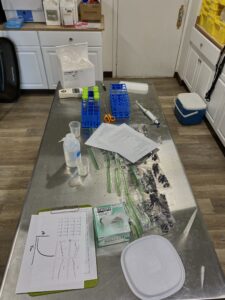
Photo credit: Melinda Cramp
Hello once again! It’s hard to believe I am in my last week of this internship. I’d like to believe I’ve come a long way since I started in mid-June, and I’m happy to say that I’ve continued to learn new skills since my last blog post in August. Some of those new things I’ve learned include taking the sugar content, pH and titratable acidity (TA) of wine grapes. To find the amount of sugar in wine grapes, we use a tool called a refractometer that measures how the grape juice bends light. This tells us the sugar content, and when the ideal harvesting time will be. Finding the pH of wine grapes is fairly simple with the use of a benchtop pH meter. Finally, to calculate the TA of wine grapes we use a pH meter, sodium hydroxide (NaOH), and burette to slowly drip in the NaOH into a known mixture of grape juice and water until the pH meter reads a certain number. Once that number has been met, we do some simple math to find our TA. All of this work has been done in Milton-Freewater with my supervisor Cody Copp and fellow intern Aiden Wiggins. Who knew so much went into growing grapes and making wine!

Photo credit: Melinda Cramp
Like I mentioned in my previous blog, I also spend some of my time at the Columbia Basin Agricultural Research Center. One new skill I’ve acquired in the last month is learning how to tell apart male and female hemp plants, and how to harvest and clean hemp plants once they’re ready. Hemp can be used for fiber, seed and flower. Additionally, my supervisor at CBARC, Don Wysocki, taught me all about land surveying and how to apply it in the real world.
This internship has truly taught me numerous life skills and field skills. I am thankful for all the opportunities that I have received from OSU and my supervisors. It was such a wonderful experience being able to work right in my own community.
– Melinda Cramp










